Do you have a book in you that is struggling to get out? This speech, delivered at a RSL meeting, explains why and how I wrote my books (which are all available as free downloads). I hope it can be of help to other fledgling authors.
What got me started with writing?
My cousin, Norman is an author. It may be part of the reason why I’m drawn to writing. I became a writer (or scribbler) quite by chance and if anything here encourages you to get some of your own adventures down on paper, then it’s been worthwhile.
How many of you have ever completed a book, even a private book? Why should we write about what we all modestly regard as our unspectacular lives on earth? Well, one primary reason is that our time here just happens to be the most spectacular and fast moving era, where constant change has done its best to overwhelm us. No-one will believe what has happened to us over these years, unless we leave some first-hand impressions behind.
I’m sure I developed my love of words and the power of words from my parents and grandparents. As new arrivals from Scotland and Switzerland, in the mid-1880s, pre-photography and TV, they had to rely heavily on words to convey impressions of this new and challenging country.
Perhaps it’s too easy now. We just take a digital photo on our mobile phone and zap it to the other side of the world, often without any attached words at all. This we regard as our way of communicating with our friends and family. That won’t count for anything in another 100 years, whereas words will live forever.
Let me discuss the four books I’ve produced, show how this change has occurred and perhaps reflect on where we may be headed. Our challenge is to see if this triggers some creative juices in you. Perhaps it will give you an idea of what to do with your old family archives that are hanging around and driving you nuts.
Book #1: WG Manners
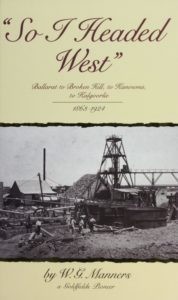 My first book, So I Headed West, had its beginnings in much this way. It’s the story of my grandfather, William G Manners. I never met my grandfather as he died 13 years before I was born. However, I’ve always been curious to know more about him. The book is in essence, his story derived from pencilled hand-notes that my father made him write down at the age of 60 as he was dying of cancer.
My first book, So I Headed West, had its beginnings in much this way. It’s the story of my grandfather, William G Manners. I never met my grandfather as he died 13 years before I was born. However, I’ve always been curious to know more about him. The book is in essence, his story derived from pencilled hand-notes that my father made him write down at the age of 60 as he was dying of cancer.
He was called WG, mainly to differentiate him from his father whose name was also William. WG was the son of a Scottish ship’s carpenter who fell in love with one of the passengers on a ship to Australia. He jumped ship and ran off to the Ballarat goldfields where, apart from marrying the young lady, he became a prospector and tangled with the authorities at the Eureka Stockade.
That family connection led to me being invited to give the keynote address at the 150th celebration of the Eureka Stockade in December, 2004. Interestingly, our Prime Minister at the time, John Howard, was invited to give a stirring address however he felt that as the flag had been stolen by the Labor Union movement he didn’t want to identify with it. I feel that was an opportunity that he missed to recapture the proud heritage of the Eureka flag. I summed up the occasion with a brief poem. This book and a collection of my other writings were put in the Eureka time capsule to be reopened in 2054 bicentenary.
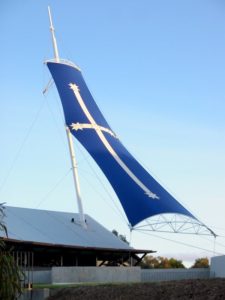 The topic of the book — getting to know my grandfather — was 100 per cent successful and it amazes me how we think so similarly on so many issues. I’m sure we would have got along very well. The book’s title, So I Headed West, came from his movement from Ballarat where he was one of the first two engineering students to graduate from the Ballarat School of Mines. He then moved to Broken Hill and then onto Kanowna, before settling in Kalgoorlie — always moving west.
The topic of the book — getting to know my grandfather — was 100 per cent successful and it amazes me how we think so similarly on so many issues. I’m sure we would have got along very well. The book’s title, So I Headed West, came from his movement from Ballarat where he was one of the first two engineering students to graduate from the Ballarat School of Mines. He then moved to Broken Hill and then onto Kanowna, before settling in Kalgoorlie — always moving west.
Holding the finished book in my hands was one of the most satisfying feelings I’d ever experienced. So I decided to do it again. This time the finished product was called Kanowna’s Barrowman, about James Balzano.
Book #2: James Balzano
When I was about 8-years-old I would accompany my father out to Kanowna (a half hour drive from Kalgoorlie) every Sunday afternoon. He was encouraging an older gentleman called James Balzano to edit his extensive diaries of the early Kalgoorlie gold rushes.
Balzano was one of the original barrowmen. He travelled about 900 kilometres, pushing his barrow gold rush to gold rush, always meticulously writing down first-hand experiences of the people and the events. In this way it marks one of the rare historical records of events as they happened, rather than a reinterpretation strung together many years later.
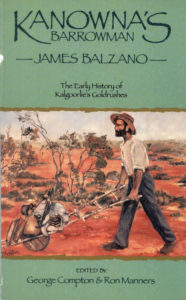 I joined forces with a colleague, a geologist by the name of George Compton, on Kanowna’s Barrowman. We had an extensive experience of prospecting on the Kanowna Goldfields and George’s father was also a noted Goldfields historian. We had a clear objective of what we wanted the book to achieve and, on page 2, stated that: “We had a desire to rescue Balzano from undeserved obscurity.” We also mentioned that with the 1992 rebirth of Kanowna through the discovery and continuing production from the Kanowna Bell Goldmine, it was appropriate to stager an annual Balzano memorial barrow race where people could push their replicas of his original barrow from Kanowna to Kalgoorlie or vice-versa.
I joined forces with a colleague, a geologist by the name of George Compton, on Kanowna’s Barrowman. We had an extensive experience of prospecting on the Kanowna Goldfields and George’s father was also a noted Goldfields historian. We had a clear objective of what we wanted the book to achieve and, on page 2, stated that: “We had a desire to rescue Balzano from undeserved obscurity.” We also mentioned that with the 1992 rebirth of Kanowna through the discovery and continuing production from the Kanowna Bell Goldmine, it was appropriate to stager an annual Balzano memorial barrow race where people could push their replicas of his original barrow from Kanowna to Kalgoorlie or vice-versa.
Coincidentally, Gary Pearce, the then Chief of Allied Insurance, walked into my office about that time and explained that Allied, along with Delta Gold and Geo Peko, the operators of the mine, were keen to stage an annual event on the Goldfields that could give them some publicity and also add to the texture of the city.
He responded immediately to my suggestion of the Balzano Barrow Race and this has subsequently been run, annually. This year’s race was the 16th and over the years this event has raised a total of over $500,000 for local charities such as the Royal Flying Doctor Service and the State Emergency Services.
Holding that finished book in my hands was an equally satisfying experience and I had the irresistible urge to do it again.
Book #3: With mum and dad
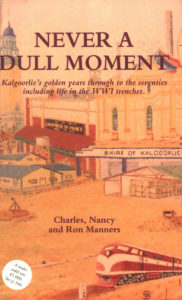 The third book was called Never A Dull Moment. I used some of my mother’s and father’s material so credited them as joint authors — without their permission as they died many years earlier. The book was enthusiastically launched in Kalgoorlie, Perth, Melbourne, Sydney and in Canberra at the Australian War Memorial.
The third book was called Never A Dull Moment. I used some of my mother’s and father’s material so credited them as joint authors — without their permission as they died many years earlier. The book was enthusiastically launched in Kalgoorlie, Perth, Melbourne, Sydney and in Canberra at the Australian War Memorial.
Sir Arvi Parbo did me the honour of launching the book in Melbourne. Now I’ll can expand a little bit on the second part of Never A Dull Moment, which I titled Then Came the War (the illustrated WWI diaries of Chas Manners and Dick Fryer-Smith, his friend and fellow forward scout/runner). I didn’t have a lot to start with, simply Dad’s WWI diary. Although Dad was Vice President of the Kalgoorlie RSL for many years, and I think edited the local RSL magazine, he never ever spoke of his wartime experience except on the afternoon of Anzac Day, after he returned from the march and the annual reunion.
So I set to work on the diary to see what I could make of it. Was it a self-supporting story? Dad’s wartime history was typical of the many frontline diggers in the muddy trenches of France, where he eventually was wounded and out of action for a short while.
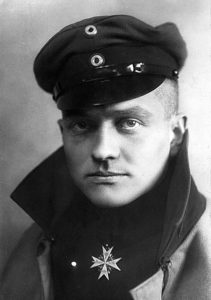 However, the events of which he was part of grabbed my attention immediately. The battles of the Western Front that have over the years become legendary and dad’s first-hand impressions made this task one that I simply had to tackle. It included everyday events such as the downing and crashlanding of the Red Barron, where dad was amongst the group who ran forward and extracted Barron Von Richthofen’s body from the plane. It also outlined the arrival of the padre, hailing from Adelaide, who then made all the diggers put back all the souvenired buttons and items they’d so keenly collected. This inspired dad to collect information on solving the question of who shot down the Red Baron. An interesting observation was the reverence in which the allies treated the Red Baron as a war hero and organized his burial accordingly. There was a code of ethics in war that doesn’t appear to exist anymore.
However, the events of which he was part of grabbed my attention immediately. The battles of the Western Front that have over the years become legendary and dad’s first-hand impressions made this task one that I simply had to tackle. It included everyday events such as the downing and crashlanding of the Red Barron, where dad was amongst the group who ran forward and extracted Barron Von Richthofen’s body from the plane. It also outlined the arrival of the padre, hailing from Adelaide, who then made all the diggers put back all the souvenired buttons and items they’d so keenly collected. This inspired dad to collect information on solving the question of who shot down the Red Baron. An interesting observation was the reverence in which the allies treated the Red Baron as a war hero and organized his burial accordingly. There was a code of ethics in war that doesn’t appear to exist anymore.
This all caused me to continue, but there were missing bits — some of the stories made assumptions that we knew the other half already (remember that this diary was simply a personal observation and there was no intention ever to have it published in this way).
Then I had the inspiration to track down the descendents of dad’s wartime colleague, Dick Fryer-Smith, a Kojonup farmer, with whom he shared his experience in the trenches. Remarkably, I discovered that Dick Fryer-Smith’s son Tony and daughter Julia had just completed the task of transcribing Dick’s own war diary. This new information, in most cases, provided the other half of each diarist’s story.
This was followed the more daunting task of splicing both diaries together. Each comment was prefaced by a ‘C’ for Charlie (my father) or “D” for Dick. Then followed the even more daunting task of editing down to 15 per cent of the total, which is now the story as published.
It’s a great read and I’ll just give you one anecdote to explain the difficulty that my father had in enlisting.
There were no mineral or market booms to lift everyone out of the survival tedium during his years of business on the Goldfields. The special quality I remember of my father was his “quiet persuasive style”. An early example showed up in his war diaries where he had been unsuccessful on his first two attempts to enlist at the Albany recruiting office. On his third, he drew attention to the astigmatism in one of his eyes (that they had given) as the reason for “turning him down” and he explained that’s why he wore glasses and he then challenged everyone to a rifle marksmanship contest. This led to their investigating his skills with a rifle and discovering he was a local champion. He never lost his marksmanship skills and much later, even though I was a member of the High School Cadet Rifle Team, he could always out-shoot me
The Australian War Memorial in Canberra were delighted to provide backup photos which augmented some of my father’s box-brownie photos of wartime scenery, hence it being launched also in Canberra.
Again, when I held this book in my hands it was the most satisfying experience that I’d ever had. So what next?
Book #4: Heroic Misadventures
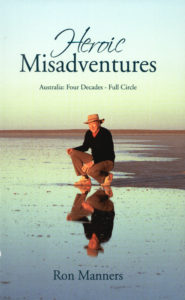 At the prompting of comments from people such as Sir Arvi Parbo I was drawn to keep going and now the next book is at the printers. Heroic Misadventures, after a very brief step backwards in time, moves quickly into the era covering 1970 through to 2007, an era in which I was an enthusiastic participant.On reflection it shows that life if all about choices and discovery, and discovery is often all about making mistakes.
At the prompting of comments from people such as Sir Arvi Parbo I was drawn to keep going and now the next book is at the printers. Heroic Misadventures, after a very brief step backwards in time, moves quickly into the era covering 1970 through to 2007, an era in which I was an enthusiastic participant.On reflection it shows that life if all about choices and discovery, and discovery is often all about making mistakes.
Samuel Crothers put it well when he said:
“Try as hard as we may for perfection, the net result of our labours is an amazing variety of imperfectness. We are surprised at our own versatility in being able to fail in so many different ways.”
On reflection, having a few failures under the belt is never terminal, it simply prepares us for subsequent successes. Throughout this book, I mention what I should have learnt from each experience. Sometimes I feel I’ve attend so many of life’s lessons that I wonder what significant future challenges I’ve now prepared myself for. I feel so fortunate to have been a participant in the past 40 tumultuous years, I’m now optimistic about the future.
This book is simply a collection of self-contained adventures, as we skip through the challenging attitudes, politics and culture of the past 40 years, with our eyes firmly fixed on the future.

1 Comment
Thanks for this helpful annotated bookography.